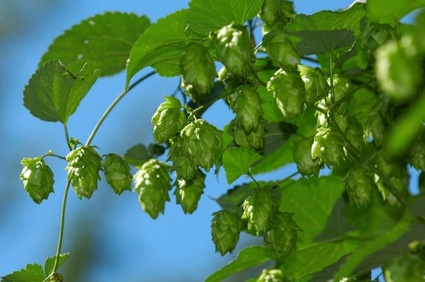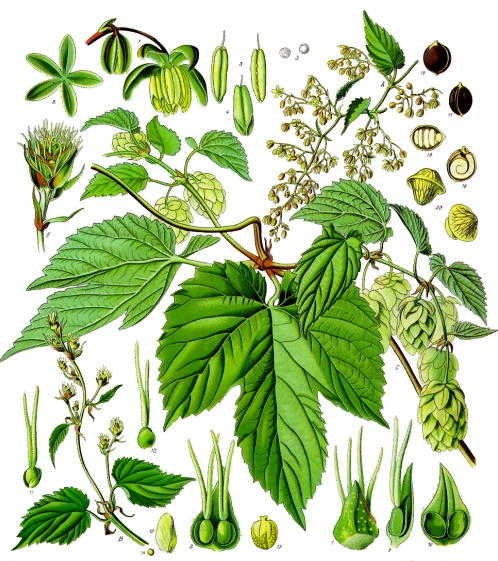
Humulus lupulus (L)
Synonyms and Common names: Lupuli strobilus, Humulus, Lupulus
German = Hopfen, French = Houblon, Spanish = Hombrecillo, Italian = Luppolo, Chinese = Lei-mei-ts�ao
Order: Cannabinaceae

Description: Humulus is a native British climbing perennial. The annual stems twist in a clockwise direction, growing up to 6m in length and giving rise to 3-5-lobed sharply-toothed leaves with a very rough surface. The smaller leaves are single lobed. The flowers are dioecious: the small male flowers occur in loose panicles in the upper leaf axils, the female ones in closely-stacked, cone-like catkins made up of bracts with tiny flowers tucked into the axils. The cones grow threefold after fertilisation, up to 5cm in length, and change colour from pale greenish-yellow to yellow-brown. This herb is found Europe to Asia and favours hedgerows, thickets and open woods.
Parts used: The dried strobiles from the female plant.
Collection: The strobiles are collected before they are fully ripe in August and September and dried carefully in the shade They should not be stored for longer than a year because the lupulin is prone to oxidation.
Constituents: Up to 1% volatile oil (humulene, myrcene, caryophylline,
farnescene); 15-25% resinous bitter principles and phloroglucinol derivatives
known as alpha acids (humulone, cohumulone, adhumulone, valerianic acid) and
beta acids (lupulone, colupulone, adlupulone); condensed tannins and phenolic
acids, flavonoid glycosides (astralagin, quercitin, rutin), fats, amino acids,
unidentified oestrogenic substances, choline, asparagin. The oil and bitter
resins together are known as lupulin.
derivatives
known as alpha acids (humulone, cohumulone, adhumulone, valerianic acid) and
beta acids (lupulone, colupulone, adlupulone); condensed tannins and phenolic
acids, flavonoid glycosides (astralagin, quercitin, rutin), fats, amino acids,
unidentified oestrogenic substances, choline, asparagin. The oil and bitter
resins together are known as lupulin.
Actions: Sedative, soporific, visceral spasmolytic, aromatic bitter, digestive tonic, hypnotic, astringent, diuretic, anti-oxytocic, male anaphrodisiac; topically bactericidal, locally antiseptic
Indications: Neuralgia, insomnia, excitability, priapism, mucous colitis, anorexia; topically for crural ulcers. Specifically indicated in restlessness associated with nervous tension headache and/or indigestion.
Therapeutics and Pharmacology: Humulus is a central nervous system relaxant used extensively to treat of insomnia, and hop pillows are very popular. The volatile oils are active here, although the valerianic acid bitter component also contributes to this action. Hop pillows induce relaxation by acting on the olfactory centre and thus on the central nervous system through the limbic system. Humulus helps relieve tension and anxiety and may be used where tension results in restlessness, headache and indigestion. Alcoholic extracts of Humulus show a strong spasmolytic action on smooth muscle and is of benefit wherever there is visceral tension, for example, in nervous dyspepsia, nervous colitis, palpitations, nervous or irritable coughs, and asthma. It reduces the effects of the nervous system on the digestive system, whilst at the same time gently stimulating the digestion.
Its relaxing and astringent actions can be applied to mucous colitis as well as tense bowel states such as irritable bowel syndrome, diverticulitis or Crohn's disease. Humulone and lupulone have an anti-inflammatory action. These constituents are also antibacterial, particularly affecting gram-positive bacteria, in a mechanism thought to involve primary membrane leakage. The herb�s antiseptic action is used in the treatment of infections of the upper digestive tract, ulcers, skin eruptions and wounds. The resistance of Gram-negative bacteria to the resin acids is attributed to the presence of a phospholipid-containing outer membrane, as humulone and lupulone are inactivated by serum phospholipids. Antifungal activity has been demonstrated towards Candida albicans, and the flavone constituents show activity against Staphylococcus aureus.
The oestrogenic substances in Humulus may cause loss of libido in men. It has been used with some success in the treatment of premature ejaculation and priapism. Recent research suggests an anti-oxytocic property, supporting the claims for its use in dysmenorrhoea and amenorrhoea (particularly when associated with anorexia nervosa).
In popular healing Humulus is used as a diuretic, for bladder inflammation, jaundice and other liver complaints, and is believed to have a hypotensive effect. Asparagin contributes to the plant's diuretic action.
Combinations: Humulus combines well with Valeriana as an hypnotic and with Chamaemelum for nervous dyspepsia.
Caution: Humulus acts as a mild depressive on the higher nerve centres and is therefore contraindicated in depression. Its sedative effects may potentiate the effects of existing sedative therapy and alcohol. The pollen from the strobiles may cause contact dermatitis and the strobiles themselves rapidly lose their effectiveness with storage. Chronic exposure to hops by those who work with them has led to nausea, vomiting, abnormal sweating, somnolence, agitation, fever, bradycardia, mydriasis, and skin reactions such as erythema, conjunctivitis and pustular dermatitis. Paradoxically, many of these symptoms are the opposite of the therapeutic effects of this herb.
Preparation and Dosage: (thrice daily)
Regulatory Status: GSL Schedule 1
Dried strobile:0.5-1g or by infusion
Liquid Extract: 1:1 in 45% alcohol, 0.5-1ml
Tincture: 1:5 in 60% alcohol, 1-2ml
Additional Comments: Pliny referred to hops as 'willow wolf', because of its tendency to twine around willows and other trees. Hops have been used in brewing since Roman times, although their introduction to brewing in England was not until the 17th century. Female hop-pickers first drew attention to the effect of the herb on the reproductive organs - they suffered disrupted or absent menstruation whilst working with the plants due to the absorption of the oil through their hands. Mrs Grieve recommends hop tea as a tonic for a sluggish liver.
Bibliography
Bartram, T. 1995 Encyclopedia of Herbal Medicine, 1st edn., Grace Publishers, Bournemouth.
Bradley, P.R. (ed.) 1992 British Herbal Compendium, Volume 1, BHMA, Bournemouth.
Bremness, L. 1994 Herbs, Dorling Kindersley Eyewitness Handbook, London.
BHMA 1983 British Herbal Pharmacopoeia, BHMA, Bournemouth.
Chevallier, A. 1996 The Encyclopedia of Medicinal Plants, Dorling Kindersley, London.
Corrigan, D. 1996 Herbal Medicine: Sleep and Relaxation, Amberwood Publishing, Christchurch
Grieve, M. 1931 A Modern Herbal, (ed. C.F. Leyel 1985), London.
Hoffmann, D. 1990 The New Holistic Herbal, Second Edition, Element, Shaftesbury.
Hyperhealth 1996 Natural Health and Nutrition Databank, v.96.1 CD-ROM, �In-Tele-Health, available from Healthworks, Leeds. ISBN 0-646-30942-0
Lust, J. 1990 The Herb Book, Bantam, London.
Mabey, R. (ed.) 1991 The Complete New Herbal, Penguin, London.
Mills, S.Y. 1993 The Essential Book of Herbal Medicine, Penguin, London (First published in 1991 as Out of the Earth, Arkana)
Mills, S.Y. 1993 The A-Z of Modern Herbalism, Diamond Books, London.
Newall, C.A., Anderson, L.A., & Phillipson, J.D. 1996 Herbal Medicines: A Guide for Health-care Professionals, The Pharmaceutical Press, London.
Ody, P. 1993 The Herb Society's Complete Medicinal Herbal, Dorling Kindersley, London.
Polunin, M. and Robbins, C. 1992 The Natural Pharmacy, Dorling Kindersley, London.
Prihoda, A. 1989 The Healing Powers of Nature, Octopus, London.
Weiss, R.F. 1991 Herbal Medicine, Beaconsfield Arcanum, Beaconsfield.
Wren, R.C. 1988 Potter's New Cyclopaedia of Botanical Drugs and Preparations, C.W.Daniel, Saffron Walden.










